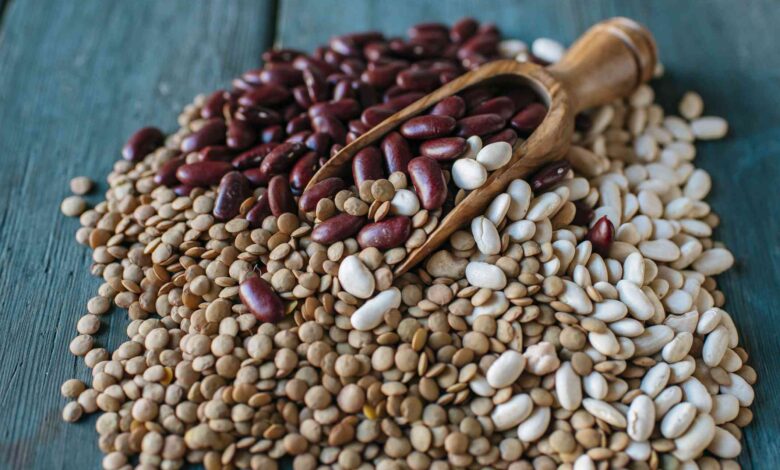Which Plant-Based Protein Is Better?

:max_bytes(150000):strip_icc():format(jpeg)/Health-GettyImages-BeansVsLentils-95f14c68a8e74d369dcfc036191607bf.jpg)
| 1 cup (198 grams) cooked lentils | 1 cup (172 grams) cooked black beans | |
| Calories | 226 | 227 |
| Carbohydrates | 38.6 grams (g) | 40.8 g |
| Fiber | 15.6 g | 15 g |
| Protein | 17.9 g | 15.2 g |
| Fat | 0.7 g | 0.9 g |
| Iron | 6.6 g | 3.6 g |
| Magnesium | 71.3 milligrams (mg) | 120 mg |
| Zinc | 2.5 mg | 1.9 mg |
| Selenium | 5.5 micrograms (mcg) | 2 mcg |
| Folate | 358 mcg | 256 mcg |
| Potassium | 731 mg | 611 mg |
Beans and lentils have similar nutrients. One is not better than the other. It’s also hard to say one bean is better than another or one type of lentil is better than another. One type may have more protein, but another may have more fiber, vitamins, minerals, or beneficial compounds.
A study comparing the nutrition of kidney beans, white beans, and lentils found that kidney beans had the most protein while canned lentils had the least. However, the difference was only by about 4 grams. Home-cooked green lentils had more protein and essential amino acids than most beans in the study.
Home-cooked and canned pulses (edible seeds of plants in the legume family) can also have different nutritional profiles. Home-cooked pulses have more protein, amino acids, fiber, vitamins, and minerals.
Another study compared the nutrition of five beans: pinto, navy, great northern, red kidney, and black. Cooked pinto beans had the most protein, while cooked navy beans had the most fiber. Cooked black beans had the most magnesium, and pinto beans had the most folate.
The American Dietary Guidelines recommend eating both beans and lentils. It’s a good idea to mix them up.
Each pulse or lentil has different ratios of soluble and insoluble fibers. They also differ in amino acid profiles, micronutrients (like vitamins and minerals), and other healthy compounds.
Beans and lentils are available canned for convenience, but you can also cook them at home. Pressure cooking cooks beans faster, while lentils are easily boiled in a regular pot. The most popular ways of using beans and lentils are:
- Beans with corn tortillas
- Rice and beans
- Eight-treasure porridge
- Gluten-free recipes
- Dips
- Soups and stews
- Beans and lentils can replace eggs in some recipes
- Bean or lentil tofu
- Pasta with beans and lentils flour
- Bread and muffins with beans and lentils flour
Lentils have many nutrients. They also contain carotenoids, which are beneficial pigments in plants. They give lentils their yellow, orange, and red colors. Beta-carotene converts to vitamin A, while lutein and zeaxanthin help protect the eyes.
Lentils have a low glycemic index, meaning they do not cause a rapid increase in blood glucose. Instead, they cause a gradual rise.
A small study looked at how high-glycemic-index foods, like white rice and potatoes, affect blood sugar. It tested these foods alone and mixed them with lentils. Mixing rice or instant potatoes with lentils (50-50) lowered blood sugar more than eating rice or potatoes alone.
Another small study tested the effects of a lentil-rich diet on blood cholesterol and glucose levels. Participants ate a daily meal that added up to either 0 or 980 grams of cooked whole green lentils per week. People who ate lentils had much lower fasting low-density lipoprotein (LDL, or “bad”) cholesterol and total cholesterol. They also had lower post-meal glucose levels.
A meta-analysis found that eating beans reduced cholesterol by 19% and the risk of heart disease by 11%.
Beans are high in carbohydrates, most of which are resistant starches. Good bacteria feed on resistant starch, turning it into gut-healthy short-chain fatty acids (SCFAs). In a study, participants who added a cup of beans to their daily diet for eight weeks saw an increase in beneficial gut bacteria.
The Dietary Guidelines for Americans recommend 14 grams of fiber per 1,000 calories. For an average 2,000-calorie diet, you need at least 28 grams of fiber. One cup of beans provides more than half of that amount. Fiber can lower cholesterol, control blood sugar, and help manage weight.
Diets that include lentils and beans can also help reduce and maintain body weight. A meta-analysis found that eating 130 grams of pulses daily can help reduce body weight. The decline was significant compared to weight maintenance and weight loss diets.
Beans contain compounds, such as phytates, lectins, and tannins, that can reduce the body’s absorption of nutrients. Phytates bind to iron, zinc, magnesium, calcium, and potassium, reducing their absorption. They can also bind to lipids (fats), reducing the absorption of fat-soluble vitamins like vitamin D.
Legumes can cause digestive symptoms in some people. They contain nondigestible carbohydrates, like alpha-galactosides, which your digestive system cannot absorb because it lacks the enzyme to break them down.
Different legumes contain varying amounts of alpha-galactosides. Common beans, soybeans, chickpeas, peas, and lentils have higher levels. These molecules travel to the colon, where bacteria ferment them. This produces gases like hydrogen, carbon dioxide, and methane, which can cause abdominal pain, bloating, distension, and diarrhea.
Several methods can reduce compounds that cause gastrointestinal discomfort. Soaking and cooking dry beans and lentils overnight decreases these molecules, but this method’s success depends on the type of legume, water and salt levels, temperature, and soaking time. Soaking and half an hour of pressure cooking can cut these molecules by 40-90% or more.
Beans and lentils contain carbohydrates, protein, fiber, and vitamins, such as B vitamins. They also provide minerals such as magnesium, iron, and potassium.
While beans and lentils have a lot in common, their nutrients can vary. One might have more amino acids, while another might have more fiber or other beneficial compounds. Instead of picking one over the other, incorporate both beans and lentils into your diet.




